Jesse Ziegler | November 29, 2021
Right after I talked my way into this GNCC race test of Ben Kelley’s FMF KTM Factory Racing 350 XC-F Factory Edition, I realized it’s all a bit much to live up to for a motorcycling mortal.
The whole scale of it all is overwhelming. But I had a plan to bring you along for the ride, and I admittedly oversold my abilities to get on this bike. Antti Kallonen, the stoic, somewhat intimidating general of KTM’s Factory Off-Road racing operations totally fell for it. So, here we go!
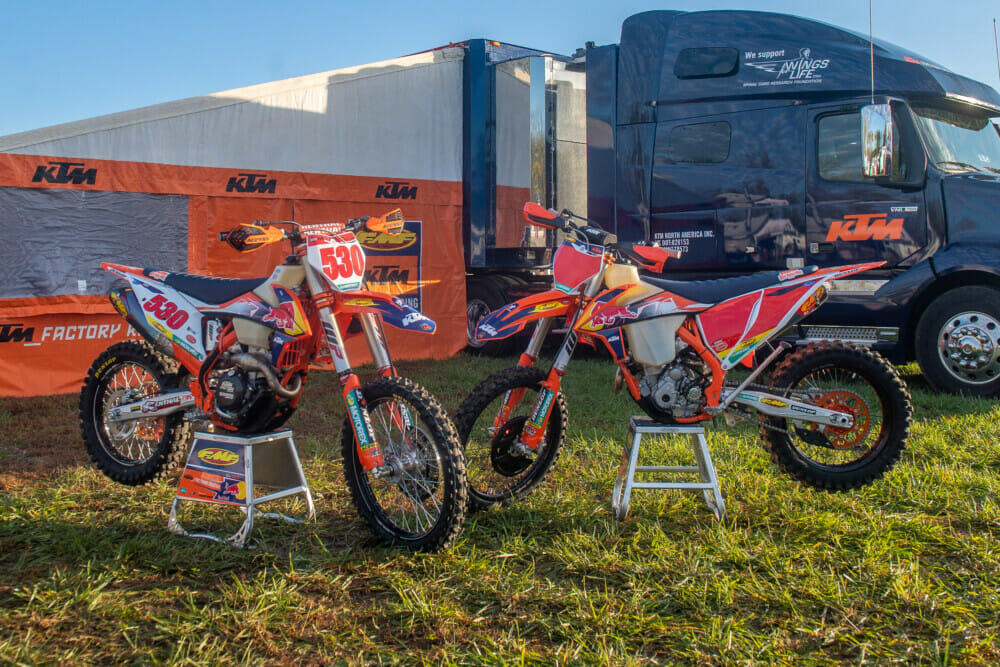 These are the same bike model. One you can buy. The other, you have to earn. Unless you’re the author. He got a ticket to ride Factory style, out of annoyance, more than talent.
These are the same bike model. One you can buy. The other, you have to earn. Unless you’re the author. He got a ticket to ride Factory style, out of annoyance, more than talent.
Photos by Shan Moore, Brandon Lesniak and Jesse Ziegler
Mother Nature Wins
First, did you see how the GNCC racing finale in Indiana ended up? It was a mess! This poor bike and everyone else went through a wet hell that day; I’ve never been outside while that much rain was falling—and stayed outside. Worse yet, I was on a starting line getting ready to race. When I rolled up, it wasn’t raining, and the soybean and cornfields were damp. By the time my umbrella guy Casey Lytle (yep, that Casey Lytle) left me, there was a small river rolling between my feet.
I wasn’t going to not race a factory race bike, given the chance. But it wasn’t necessarily a reasonable thing to do this day. In the moment, it was much smarter than my original plan.
My original plan was to race two bikes: One, the newly released 2022 KTM 350 XC-F Factory Edition you can go to your dealership and buy today; Two, this fire-breathing weapon that you can’t buy. Mother Nature didn’t let that plan happen (thanks, mom!) but I did get a full day prior to the race on both bikes to build a nice comparison. And when it came time to race on Sunday, you know which one I picked. You can read about the 2022 KTM 350 XC-F Factory Edition here.
 Ben Kelley’s GNCC Championship-winning 350 is purpose built to rip.
Ben Kelley’s GNCC Championship-winning 350 is purpose built to rip.
But the race, man what an exercise in survival for both man and machine. The weather and popularity of the Ironman GNCC this year led officials to split into two and cut the morning race down from two hours to one-and-a-half. That didn’t stop me from racing for two hours and 47 minutes during a 1.5-hour race. Right from the start, conditions were bad, and they got worse. My lap times followed suit with my third and final lap tanking one hour and 15 minutes all by itself. I didn’t stand up much on that last lap, as navigating the course required my legs to be propped to the side like outrigger skis. Plus, I was about to pick my bike up out of a mud hole again, so why bother standing up, right?
The environment was a mix of cold water from the sky, heavy slop from the earth, and a bitter smell of boiling coolant steaming from my crotch. Everywhere I rode that morning were victims. Bikes expiring with riders waiting for a rescue, riders having moments of clarity and leaving the race, abandoned bikes where riders just left them—it was chaos everywhere. I picked Ben’s bike up at least 10 times and it never really fell over. I don’t think I had a traditional crash during the day. I would ride, fall into a rut or mud hole, and it just sort of stopped moving forward. So, I’d jump off and lift it up or drag it around until it somehow started going forward again. And this is how it went for almost three hours.
 Casey Lytle, former pro MX and Supercross racer and head of the U.S.-based KTM Research and Development team, was nice enough to hold an umbrella for us.
Casey Lytle, former pro MX and Supercross racer and head of the U.S.-based KTM Research and Development team, was nice enough to hold an umbrella for us.
I remember thinking, and I think I say this in the video (scroll to bottom of page for 2022 KTM 350 XC-F Factory Edition Vs. GNCC Factory Race Bike
video), I don’t think a Factory race bike has ever gone this slow or made this many bad race-line decisions. It must have been very frustrated and bored with me. But it survived! Somehow. Just like Ben Kelley did in the afternoon race to win his first GNCC XC1 championship. It was certainly not an easy task.
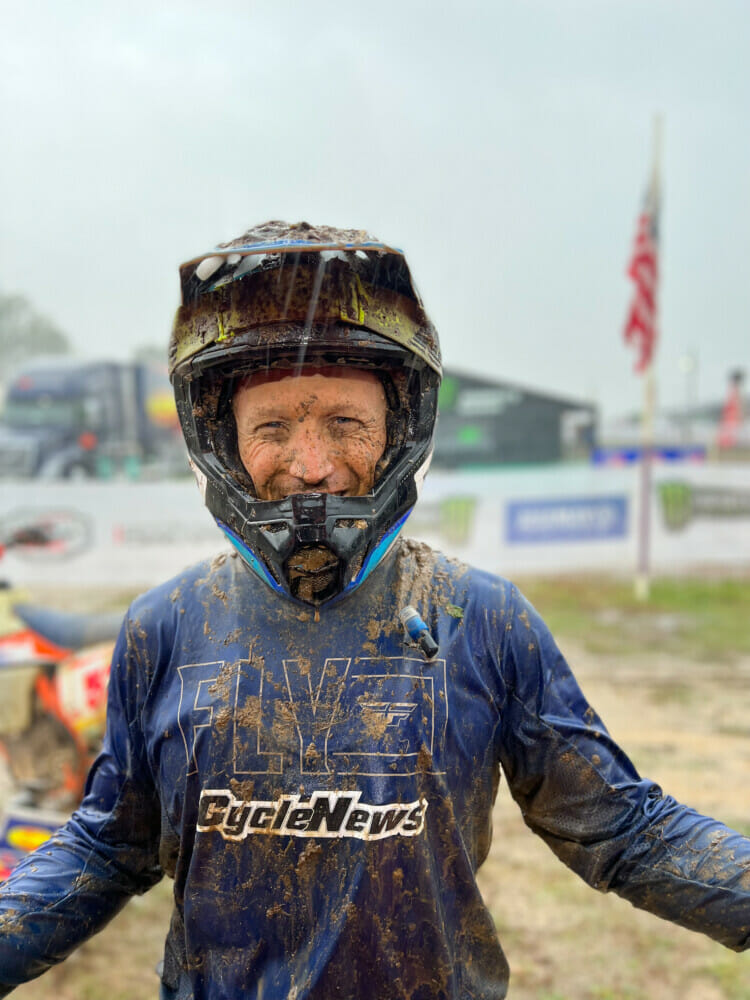 It was one of those “fun when it’s over” sort of races. We were happy to survive, finish, deliver Ben’s bike in one piece and, for sure, we were impressed by everyone giving it a go.
It was one of those “fun when it’s over” sort of races. We were happy to survive, finish, deliver Ben’s bike in one piece and, for sure, we were impressed by everyone giving it a go.
KTM Dominance
The ladies and gentlemen that line up on the professional racer rows of a GNCC starting grid are not necessarily like you and me. They’re bigger than I am/we are. They do motorcycle racing things I can’t. And they do them quite easily, very often, and for longer longer. And some of those same motorcycle things I can’t do at all.
Case in point, stacked against the WXC Women’s Pro racers that morning, I would have finished about midpack in class. That’s fifth place or so just based on time and laps completed. The winner, Rachael Archer, had a 46-minute final lap. That’s a half-hour faster than mine. Which makes sense since she finished about an hour before I did overall. As it was, I finished fourth in an Industry class behind Barry Hawk (who’s done this before), Axell Hodges (who’s certainly not a normal person when it comes to motorcycle riding), and Quinn Cody (who we don’t really talk about beating me anymore because it’s getting old). I was the first normal person, in my opinion. Yeah, let’s call it that.
Chances are, you’re a lot like me in that you want to do the things these others do on your motorcycle, too. But I hope you’re honest enough with yourself to know you really can’t. That’s the difference between mortals and those other things that get paid to race. We’re in touch with earthly reality. They are not.
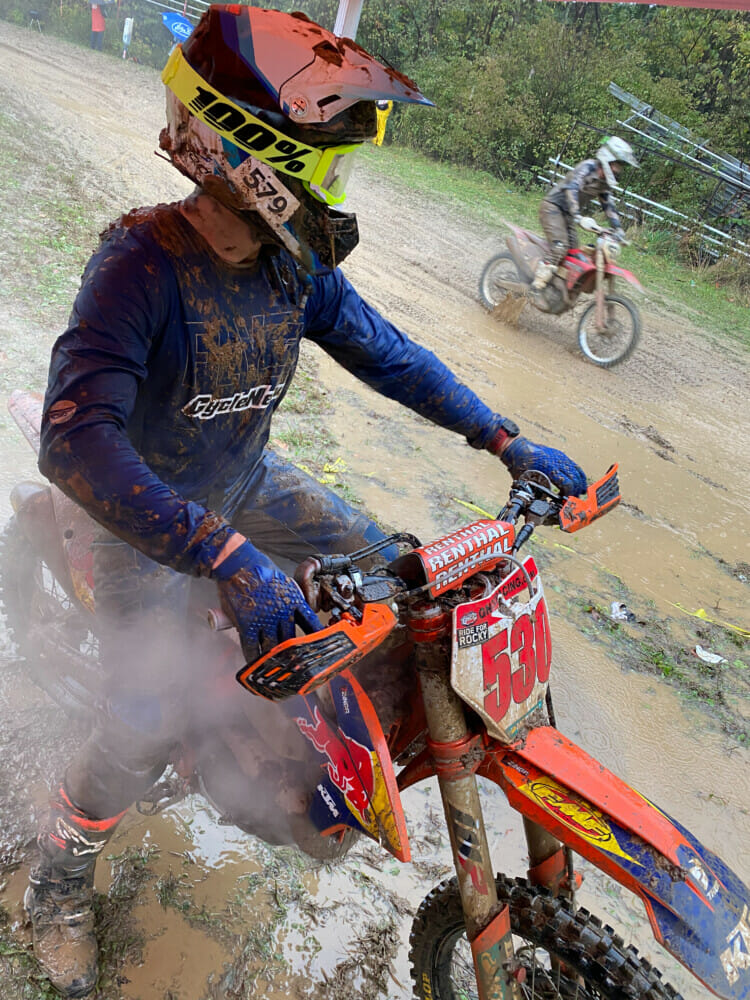 This was two laps in and the first goggle swap. The good news is the bike still has coolant to steam, the bad news is that it would be over an hour before I made it around the course again. Brutal is putting it lightly.
This was two laps in and the first goggle swap. The good news is the bike still has coolant to steam, the bad news is that it would be over an hour before I made it around the course again. Brutal is putting it lightly.
At the top of this immortal-racer pyramid is the most dominant team structure in off-road motorcycling I can find—the FMF KTM Factory Racing GNCC team. This team does not compromise. It just wins. A lot. Repeatedly. Consistently. In championship after championship after championship fashion. They don’t win every event every season. But they absolutely expect to. And it shows in everything they do. Except for letting me ride their bike.
When it comes down to championships, they’re almost unstoppable lately. KTM hasn’t lost an XC1 title in nine straight seasons thanks to an eight-year-straight run by Kailub Russell and a very stressful final-race championship hand-off to 2021 champ Ben Kelley. This year was a nail-biter. And the stress didn’t stop until the checked flag flew, I can tell you. But KTM was on top again in the end. It’s fitting, as the mighty orange effort has won 15 of the last 22 XC1 Championship seasons. The last time KTM didn’t win the championship was 2012.
2012 was three jobs, two-and-a-half kids, four dogs, three houses, a couple cars, and about six motorcycles ago for me. I wasn’t even married in 2012 and I don’t remember what not being married is like.
So, I’m a natural fit here. I haven’t won anything. And I don’t expect to. They let me ride Ben Kelley’s bike—suckers!
 IMS adds smiles per gallon and Renthal connects the rider. The factory builds are perfect in-between it all.
IMS adds smiles per gallon and Renthal connects the rider. The factory builds are perfect in-between it all.
The Factory Advantage
And I mean perfect for Ben Kelley, here. They already made a perfect bike for me. I can buy it at a dealership. Ben Kelley gets more.
At the factory level, everything from crank balancing and EFI tuning to footpeg positioning is done at such a high level you can feel the cohesion of the project built to win. It’s like walking into a building that was conceptualized, designed, engineered and constructed with laser-focus intent, and then personalized just for you. Everything works in harmony and feels like home. The same is happening here. But the architect, contractor and interior designer is Kelley’s mechanic Joseangel Cordova and the KTM Factory behind him.
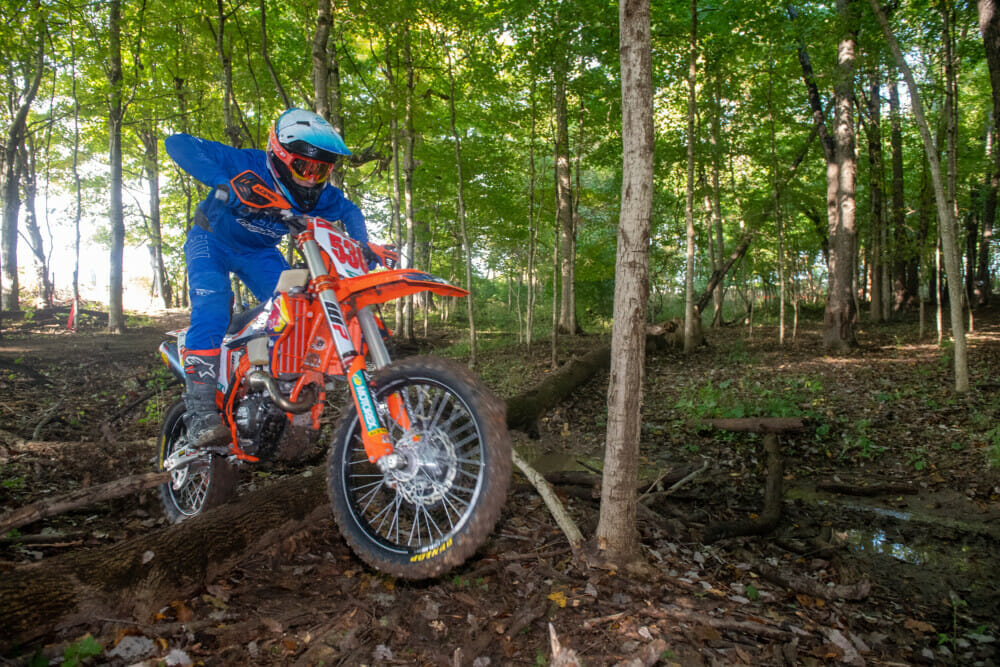 Welcome to the woods. While tree obstacles weren’t much of an issue out in the mud, we still managed to hit a few and Ben Kelley’s bike didn’t flinch.
Welcome to the woods. While tree obstacles weren’t much of an issue out in the mud, we still managed to hit a few and Ben Kelley’s bike didn’t flinch.
In the trenches of GNCC, the magic blend of perfection is all about delivering traction, speed, control, and durability in the face of truly brutal conditions. GNCC racers face rocks, roots, grass, dust, hardpack, knee-deep mud and very hard trees, often in a single lap. The bikes need to not only rip a holeshot from a dead-engine start, but they need to have the legs to stand on a smashed radiator in a Florida swamp after three hours on the rev-limiter dodging palmetto roots in the sand. They must do all this while encouraging and inspiring their pilots to ignore the urge to barf and quit.
If you think about what we’re asking from these bikes for a second, it’s damn impressive. And while a stock 350 XC-F Factory Edition is all I’ll ever need, experiencing the Factory advantage difference is remarkable.
 One of the most custom things on Ben Kelley’s bike is a front-brake caliper with oversized pistons. This allows increased braking performance without going bigger on the rotor, which could be more easily damaged off-road.
One of the most custom things on Ben Kelley’s bike is a front-brake caliper with oversized pistons. This allows increased braking performance without going bigger on the rotor, which could be more easily damaged off-road.
Line ‘Em Up
I think it’s obvious everyone would choose a Factory bike over a stock bike, given the chance. But I’ve ridden other people’s Factory bikes that just don’t work for me/normal people. And while Ben Kelley’s factory bike is built specifically for him, I honestly think most normal, mortal people like me would be absolutely in love with it as their own race bike. It’s that easy to ride. And ride fast. It oozes speed. It wants to go fast, faster, fastest until it needs to stop. And then it stops fast, too. It’s crazy like that.
Ben Kelley’s Factory KTM motor is not making a lot more horsepower than a stock 350. I’m not a dyno and I don’t care about HP numbers that much anyway, but on the dirt, the bike is clearly delivering power more efficiently and propelling the bike through the woods more effectively than the stocker. It’s smooth, in a word, on acceleration with a building surge of mid- to top power that is a beautiful enhancement of a 350’s natural power curve. I didn’t feel a spike or hit anywhere. This was a lot like Knight’s 450 of the past. His bike was so smooth, it was deceptive. Kelley’s bike fit that bill, too.
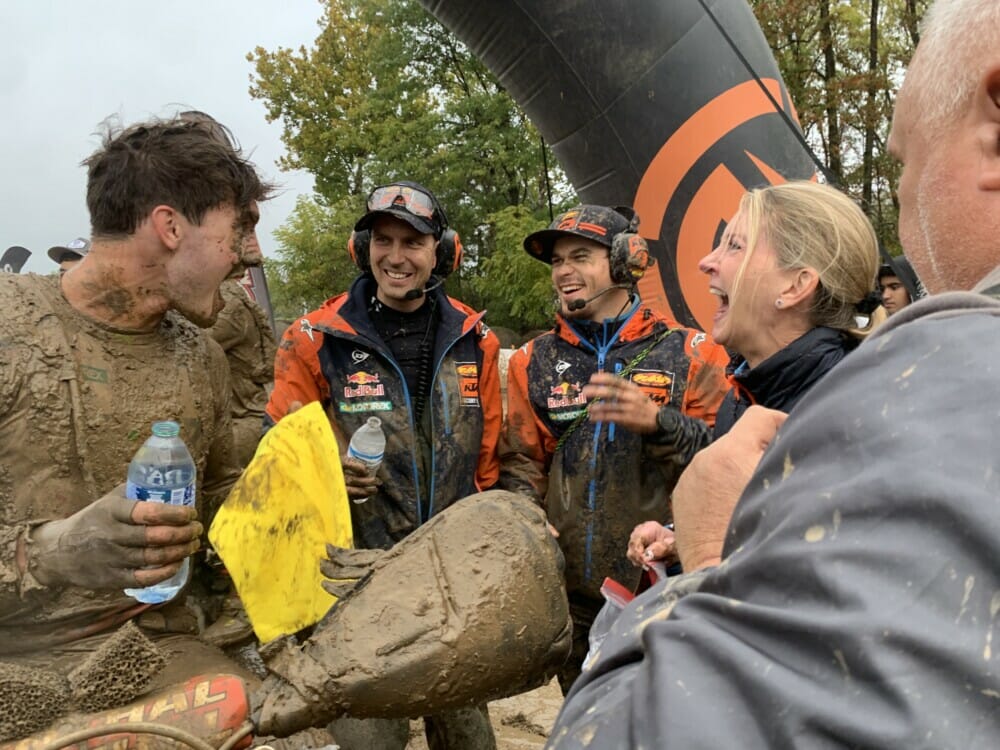 Ben Kelley, KTM’s Off-Road Race Team Manager Antti Kallonen, Kailub Russell and Ben’s mom Dawn (L to R) celebrate Ben’s first GNCC Championship immediately following the hectic final round.
Ben Kelley, KTM’s Off-Road Race Team Manager Antti Kallonen, Kailub Russell and Ben’s mom Dawn (L to R) celebrate Ben’s first GNCC Championship immediately following the hectic final round.
Ergonomically, Kelley’s bike is a little stretched out for me. He’s over six feet tall and has bigger feet than my size 10s. So his footpegs are lower and pushed back and his seat is taller than stock. That’s the only thing that felt a little awkward to me. So, I put the stock seat on for the race. His handlebar position, lever angles, and all that highly personalized stuff was easy for me to ride with right off the stand.
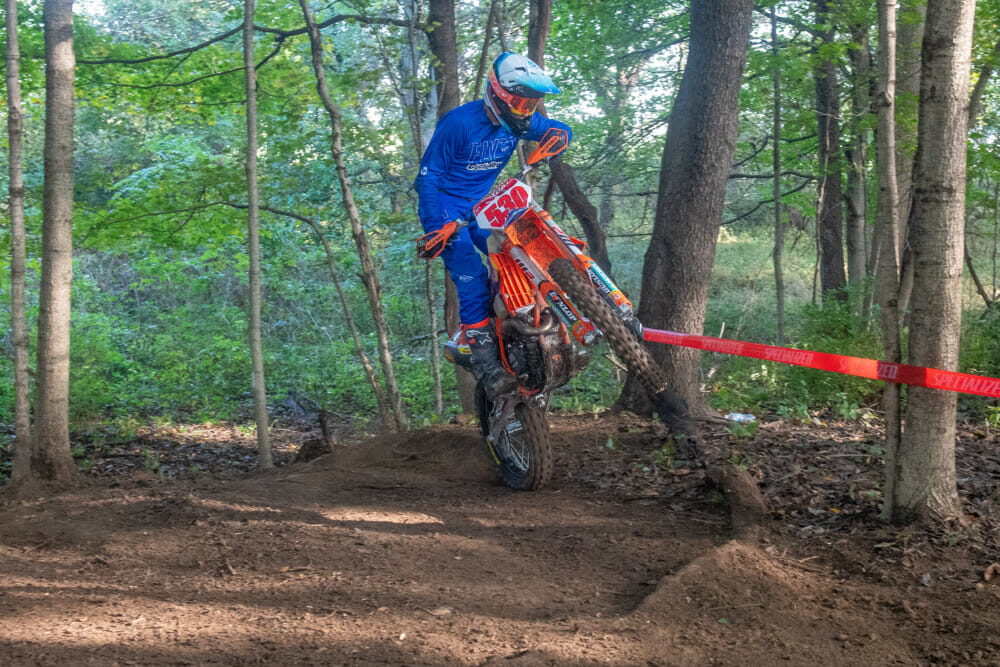 You will not find more varied terrain than around a lap of a GNCC course. A factory race bike needs to handle them all with consistency and speed. The author holds on the best he can.
You will not find more varied terrain than around a lap of a GNCC course. A factory race bike needs to handle them all with consistency and speed. The author holds on the best he can.
One of the hardest things to get and get working right, besides a factory motor—which you can’t get—is suspension. And with KTM’s WP Pro Components suspension bits, you can buy them, but they are expensive. And then you need to communicate with the shop to set them up for your normal person skill level. At that point, I don’t know if you’re really feeling the benefits of the fat tubes, cone valves and fancy clicker thingies. I’ve ridden a lot of sets of WP Pro Components on a lot of different bikes, and they can be set up great or poorly, just like any other set of suspension.
I asked Ben Kelley before I rode his bike if he thought his suspension style was stiff, soft or something else. He said his stuff was probably on the stiffer side than other racers, but he expects it to move when it hits things. He needs it to stay up high in the stroke at speed but react to obstacles smoothly. I think he knows what he’s talking about. While I certainly wasn’t getting it to move as easily as his speed can, I could feel the valving opening more freely than you’d expect from riding it around the pits. The bike stays tall in the stroke. And its stiffness is misleading as you almost think it’s going to be harsh. It’s not. It’s resistant to movement a bit, but as soon as it’s tasked to do so, it moves just fine.
 A bike this beautiful is a terrible thing to waste. Unfortunately, it will never look like this again after what we put it through. It still works fine, though!
A bike this beautiful is a terrible thing to waste. Unfortunately, it will never look like this again after what we put it through. It still works fine, though!
Remember; I did most of my testing of this bike in great conditions the day before the race. But I can tell you that during the deluge of chaos that ensued Sunday afternoon, I was sure glad I was on a smooth, powerful bike, and not something that was trying to murder me. His bike was remarkably easy to survive on. The 350 feels light and lets you change lines from mud-pit-of-death to slightly less deadly mud-pit in a flash. But it has the ponies to simply bury the throttle and blow through a slop-filled field when needed. I did both, often and the bike didn’t miss a beat.
I could have used a softer suspension setting. Even though the bike had 400 pounds of mud on it, I could still feel Ben’s bike’s aggression in some spots. It certainly really didn’t matter in the conditions or in the race, but it was noticeable.
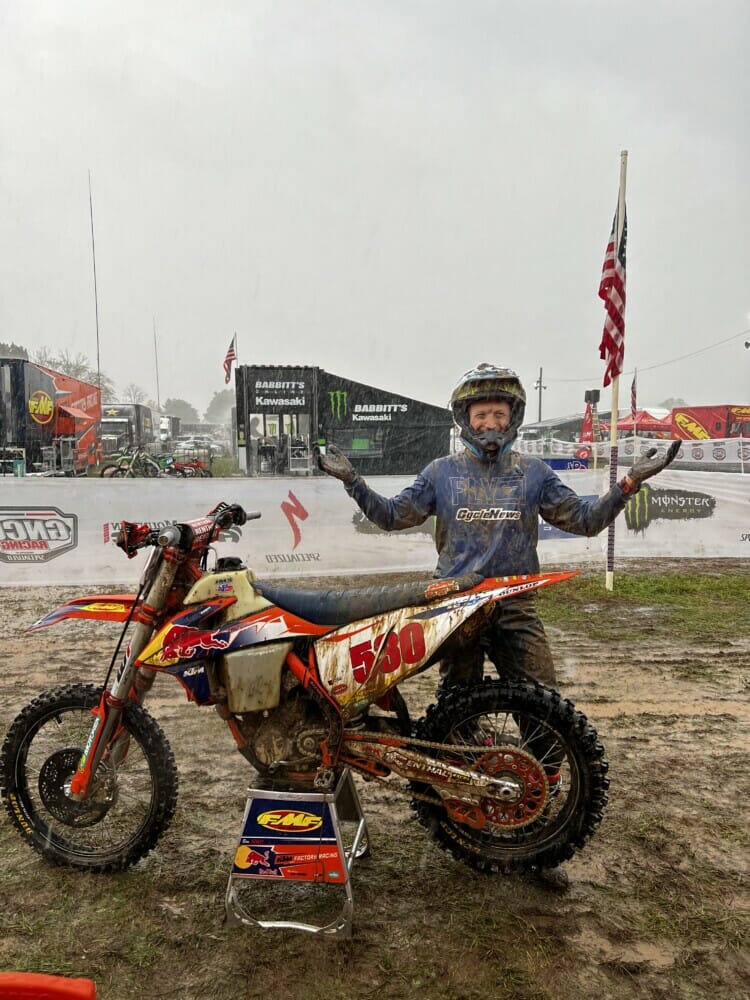 Here’s proof that Ben Kelley’s bike was ridden by a moron in moronic conditions. But they both lived to tell the tale.
Here’s proof that Ben Kelley’s bike was ridden by a moron in moronic conditions. But they both lived to tell the tale.
The Other Factory Advantages
There are probably more modifications done to Ben Kelley’s race bike than the team told me about. But from what they did tell me, I can quickly pencil out that most of the modifications they make are for survival. Redundancies in the starting, charging and electrical system including customized and, in a way, simpler wiring-harness arrangements, safety measures against loose bolts and other crucial components, reinforcements to deflect crash damage away from DNF territory, amplified cooling capacity/functionality, and more are all built in-house at KTM’s off-road race shop in California to get the bike to the finish line.
There are more teams investing more resources into trying to beat KTM than ever before. And while they knock them off the top step at a race here and there, the team that’s won so many championships keeps winning more. Their current rider lineup of Ben Kelley and Josh Toth is young, fast, and getting faster. Kailub Russell left a legacy they are intent on defending and he, himself, is in the trenches with Kelley and Toth adding confidence to their programs every week.
And then you have the team. Countless people in the trenches during an event scouting lines, sharing information, offering advice, providing support, and creating an orange-friendly environment. This is not an accident. It’s a plan. A plan to maximize on the investment of KTM’s GNCC racing focus and one that simply keeps working.
 The author and his dream bike. You’d be smiling, too, if they gave you permission to ride, let alone race, this absolute weapon of a dirt bike
The author and his dream bike. You’d be smiling, too, if they gave you permission to ride, let alone race, this absolute weapon of a dirt bike
Go See It
You must see it to believe it. All of it. GNCC racing is a spectacle, a festival, a motorcycle race and a traveling lifestyle wrapped with more passionate participation than I can accurately describe here. And at the top of it all is the KTM team, investing the most to win every year—an impressive operation to see with your own eyes, for sure.
I encourage everyone to get to a GNCC race. Maybe you don’t even want to race one, but if you’re a motorcycle fan, go and watch and see how the teams work and how the fans live and how the amateurs race on Sunday morning and the pros race in the afternoon. You’ll soon see why everyone who lines up on Sunday wants to be on the KTM Factory team, too. CN
VIDEO | 2022 KTM 350 XC-F Factory Edition Vs. GNCC Factory Race Bike
